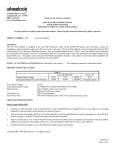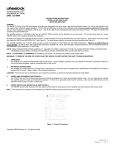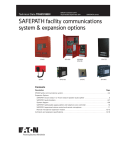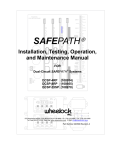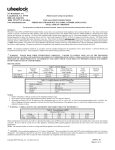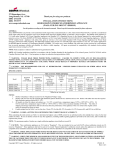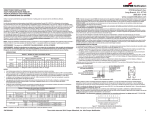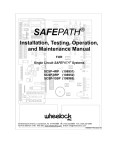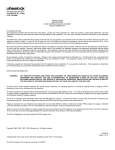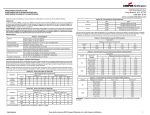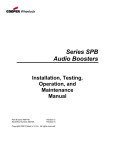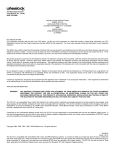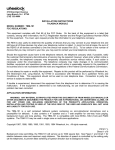Download Wheelock AIM-3 Instruction manual
Transcript
273 Branchport Avenue Long Branch, NJ 07740 (800) 631-2148 www.wheeelockinc.com Thank you for using our products. INSTALLATION INSTRUCTIONS AUXILIARY INPUT MODULE Use this product according to this instruction manual. Please keep this instruction manual for future reference. Model Numbers: AIM-3 107387 Auxiliary Input Module General: The AIM-3 is an outboard expansion module for use with the SAFEPATH control panels to expand the number of optional Remote Microphones (RM) from 1 to 3. The module is compatible with all SAFEPATH panels and Remote Microphones. The PCB assembly is mounted in an enclosure. READ THESE INSTRUCTIONS CAREFULLY BEFORE USING THIS PRODUCT. NOTE: All CAUTIONS and WARNINGS are identified by the symbol RM PORT . All warnings are printed in bold capital letters. INPUT PORT SAFE PATH RM PORT 1 REMOTE MICROPHONE 1 RM PORT 2 REMOTE MICROPHONE 2 RM PORT 3 REMOTE MICROPHONE 3 AIM-3 PANEL OR TELEPHONE PAGING Figure 1. Basic Capabilities of the AIM-3 NOTE: Up to 3 Remote Microphones or up to 2 Remote Microphones and a telephone page port, may be connected to a SAFEPATH Panel with an AIM-3. NOTE: When using the AIM-3 for telephone paging on a SAFEPATH panel that is using Remote SAFEPATH panels for strobe activation, the strobe circuits connected to the Remote SAFEPATH’s will activate during a telephone page. Copyright 2003 Wheelock, Inc. All rights reserved. AIM-3 Manual Rev. C July 2003 P83667 C Sheet 1 of 12 Technical Specifications: Electrical Input Voltage 24VDC Input Current 100mA Telephone Page 60mA RM Page 40mA Standby Audio Input 1Vrms Mechanical Dimensions (H x W x D) 13.0" x 7.6" x 2.15", 33cm x 19.4cm x 5.4cm Weight 3.8 pounds, 1.7kg Enclosure 0.050" Steel Finish Black Mounting Indoor Surface Mount Top and Bottom Wiring Entry Environmental (Meets UL requirements) Operating Temperature 0° to +49° C, 32° to 120.2 ° F Storage Temperature -20° to 70° C, -4° to 158° F Humidity 85±5% @ 30±2° C Non-condensing Installation: AIM-3 Manual Rev. C July 2003 P83667 C Sheet 2 of 12 The lives of people depend upon your safe installation of the AIM-3. Please read, understand and follow the specific installation instructions set forth below to avoid damage to the AIM-3 and equipment connected to it. Installation should be conducted only by qualified persons in accordance with procedures in this manual. WARNING: SHUT OFF ALL POWER BEFORE STARTING THE INSTALLATION. ELECTRICAL SHOCK CAN CAUSE DEATH OR SERIOUS INJURY. CAUTION: The AIM-3 printed circuit boards are sensitive to static electricity and have delicate components mounted on them. Before handling either a board or any component on a board, discharge any static electricity from your body by touching a grounded object such as a metal screw which is connected to earth ground. Handle the board by its edges, and be careful not to twist or flex it. The AIM-3 is to be installed in a static free area and the user is to properly attach grounded wrist straps before touching any static sensitive areas. After handling AIM-3 printed circuit boards, the Series AIM-3 should be tested in accordance with the “System Checkout” section to verify that the printed circuit boards are undamaged and functioning properly. CAUTION: The Authority Having Jurisdiction (AHJ) should be consulted by the installer prior to installation. Installation Guidelines: 1. Prepare a drawing of the complete system wiring. (Keep a copy of the system wiring drawing and the AIM-3 Manual with the SAFEPATH panel for reference during the life of the system.) This manual shall be made available to all qualified personnel who operate, test, maintain, or service SAFEPATH products. 2. Carefully unpack the AIM-3 and make sure each item described on the packing slip is present and undamaged. 3. Mount the AIM-3 in the desired location as described in the "Mounting" section. 4. Mount any additional wiring boxes or junction boxes needed to interconnect field wiring. 5. Connect conduit fittings or bushings as needed using knockouts provided on the top and bottom of the AIM-3 units (see Figure 2). 6. Install field wiring in conduit when necessary, following the National Electrical Code and local codes for the type of system being installed. Make all necessary connections at any additional wiring or junction boxes. CAUTION: Provide proper strain relief for all wiring not in conduit. 7. Connect the AIM-3 to earth ground, following the National Electrical Code and local codes for the type of system being installed, as described in the “Grounding” section. 8. Check the integrity of all field wiring following the directions in the "Field Wiring Checkout'' section. Confirm that the specified cable is installed and that there is continuity between required points (no open circuits), with no unwanted connections (shorts) to other conductors, chassis, or earth ground. 9. Connect the wiring to the appropriate terminals of the AIM-3 modules following the directions in the "Field Wiring" section and the system wiring drawing you created in Step 1. 10. Set the switches for the proper configuration as described in the “Configuration” section. 11. For telephone applications set page volume as described in the “Operation” section. NOTE: The AIM-3 has no user controls or interface. Once it is installed and configured the enclosure is closed up. AIM-3 Manual Rev. C July 2003 P83667 C Sheet 3 of 12 Wiring Guidelines: Although the AIM-3 incorporates signal verification and noise filtering circuitry on its input, induced voltages or “noise” on the input wiring can cause improper operation. Therefore, use shielded twisted pair wire for all file input wiring. The audio output lines (and the auxiliary music input lines) should also be wired with shielded twisted pairs to minimize noise pick-up. For all other connections, twisted pairs are recommended so as to reject common mode noise, shielding is optional. The shield of each cable should be connected only at one end. Each shield of each cable that connects to the AIM-3 is to connect to the grounding points provided near the right edge of the chassis (see Figure 2). WARNING: ALL AIM-3 WIRING SHOULD BE ROUTED AWAY FROM ANY HIGH VOLTAGE OR HIGH CURRENT LINES (SUCH AS AC OR DC POWER LINE, AUDIO POWER LINES, AND MOTOR OR RELAY ACTUATION LINES) AND SHOULD BE INSTALLED IN SEPARATE CONDUIT FROM HIGH VOLTAGE OR HIGH CURRENT LINES. FAILURE TO DO SO MAY CAUSE ELECTRICAL SHOCK WHICH CAN RESULT IN PROPERTY DAMAGE AND SERIOUS INJURY OR DEATH TO YOU AND/OR OTHERS. The National Electrical Code defines two types of circuits for protective signaling systems: power limited circuits and non-power limited circuits. All AIM-3 circuits have been designed as power limited circuits. Therefore, in order to maintain power limited ratings, circuits connected to the power supply, auxiliary source input, and relay contact terminals of the AIM-3 must be powered limited. CAUTION: The National Electric Code limits the maximum number of conductors that can be installed in conduit and wiring boxes depending on the size of the conduit, the volume of the boxes, and the gauge of the wire used. Make sure that wiring used for AIM-3 installation complies with the latest NEC requirements for power limited circuits. Wiring Specifications: Between each RM and AIM-3 Cable Size: 14 - 22 AWG Shielded. The shield must be connected only at the SAFEPATH Panel. Maximum Length: 1000 Feet Maximum Capacitance: . 05uF/Total Run (50pF/foot for 1000 FT.) Mounting: The AIM-3 shall be mounted in a location within the environmental limits specified in the latest UL Standard for indoor control panels. The AIM-3 shall not be located in a hazardous location. Refer to the "Technical Specifications'' section. CAUTION: In order to comply with the latest NFPA and UL requirements for interconnection of fire alarm control equipment, the AIM-3 unit must be located in the same room as, and within 20 feet of the SAFEPATH Panel it is connected to. Refer to Figure 2 for AIM-3 mounting hole layout. Drill mounting holes for appropriate screws and anchors to ensure secure mounting to the type of surface at the selected location. Keep out dust and dirt during installation. Dust and dirt can interfere with the operation and reduce the life of the equipment. Remove the outer cover and mount the Series AIM-3 at the selected location. Use care to avoid damage to the PC board during installation. Do not apply excessive pressure to the PC board or its components, including field wiring terminals and connectors or damage may occur. AIM-3 Manual Rev. C July 2003 P83667 C Sheet 4 of 12 CONDUIT KNOCKOUTS 2 PLACES, BOTH ENDS 6.00" MOUNTING HOLES GROUND TERMINALS 11.00" MOUNTING HOLES Figure 2. AIM-3 Mounting NOTE: Drawing is not to scale. AIM-3 Manual Rev. C July 2003 P83667 C Sheet 5 of 12 TB2 RMS #1 - + RM AUDIO RM POWER - + RM TXD RM RXD REMOTE MICROPHONES 1 2 3 4 5 6 + RM AUDIO RM TXD RM RXD + RM POWER - SAFEPATH PANEL TB1 RM POWER + POWER - - + TB3 RMS #2 AIM-3 SWITCH CONFIGURATION: SWITCH POSITION SEL. 1, 2, 3 ON AS NEEDED PHONE OFF RM/PHONE RM TALK BATT TALK BATT OFF - + RM AUDIO RXD RM TXD RM RXD RM RXD REMOTE MICROPHONE 1 2 3 4 5 6 RM POWER RM TXD + AUDIO TXD RM AUDIO + RM AUDIO RM TXD RM RXD + RM POWER - REMOTE MICROPHONES RMS #3 - + RM AUDIO TB4 RM POWER - + RM TXD RM RXD 1 2 3 4 5 6 + RM AUDIO RM TXD RM RXD + RM POWER - AIM-3 Figure 3. Wiring Diagram with up to 3 Remote Microphones NOTE: If the AIM-3 is configured for less than 3 Remote Microphones, the +/- RM AUDIO terminals of the unused Remote Microphone port must be terminated with the supplied listed 10K ohm 1/4W resistor. AIM-3 Manual Rev. C July 2003 P83667 C Sheet 6 of 12 Telephone Input Applications: The AIM-3 can be connected to an unused CO Port, a page port, an analog station port ( with TPI-100 ) or to a zone control (MCZ144 ). When it is used for telephone paging, it should only be used for telephone paging only and not for background music. The VOLUME adjust is used to set the telephone page volume. When using the AIM-3 with the single circuit SAFEPATH (SC-SAPE ), verify the SC-SAPE controller software (U5) is Rev E or higher. When using the AIM-3 with other SAFEPATH panels, verify the controller software (U3) is Rev D or higher. Failure to do so could result in improper operation. AIM-3 SWITCH CONFIGURATION: UNUSED CO PORTS TIP + AUDIO SWITCH UNUSED CO PORT NC TXD RXD/CC NC NC = NO CONNECTION + POSITION RING - NC SEL. 1, SEL. 2 ON AS NEEDED SEL. 3 OFF PHONE ON RM/PHONE PHONE TALK BATT TALK BATT ON POWER CC - NC RMS-3 OF AIM-3 Figure 4. Unused CO Ports AIM-3 SWITCH CONFIGURATION: PAGE PORT + AUDIO - + AUDIO OUT SWITCH POSITION - TXD SEL. 1, SEL. 2 ON AS NEEDED SEL. 3 OFF PHONE ON RM/PHONE PHONE TALK BATT TALK BATT OFF RXD/CC + POWER CC CONTACT CLOSURE RMS-3 OF AIM-3 PAGE PORT Figure 5. Page Port AIM-3 Manual Rev. C July 2003 P83667 C Sheet 7 of 12 AIM-3 SWITCH CONFIGURATION: ANALOG STATION PORT + + AUDIO ZONE 1 - AUDIO MZEM-3 BOARD ONE WAYZONE CENTRAL AMP - TXD + NC ZONE A RXD/CC - SWITCH POSITION SEL. 1, SEL. 2 ON AS NEEDED SEL. 3 OFF PHONE ON RM/PHONE PHONE TALK BATT TALK BATT OFF GND + POWER CC -24VDC - RMS-3 OF AIM-3 + AMP 1 MZC-144 TALKBACK DEFEATED MAIN UNIT ZONE AMP PROGRAMMED ZONE ENABLES ZONE 1 & ZONE A Figure 6. Analog Station Port AIM-3 SWITCH CONFIGURATION: ZONE CONTROL ZONE 1 AUDIO TXD AUDIO MZEM-3 BOARD ONE WAYZONE CENTRAL AMP SWITCH POSITION SEL. 1, SEL. 2 ON AS NEEDED SEL. 3 OFF PHONE ON RM/PHONE PHONE TALK BATT TALK BATT OFF ZONE A RXD/CC GND POWER CC 24VDC RMS-3 OF AIM-3 AMP 1 MZC-144 TALKBACK DEFEATED MAIN UNIT ZONE AMP PROGRAMMED ZONE ENABLES ZONE 1 & ZONE A Figure 7. Zone Control AIM-3 Manual Rev. C July 2003 P83667 C Sheet 8 of 12 Field Wiring Checkout: Refer to NFPA for guidelines on testing signaling system wiring. CAUTION: Do not connect input voltage to any equipment until the field wiring has been inspected, tested and approved. 1. Verify that the field wiring is in full agreement with this manual and with the detailed wiring layout prepared for this installation. Ensure that no unwanted voltages are present on circuit conductors and ground. 2. Test all ungrounded connectors for electrical isolation from ground. 3. Test all wires that are not intentionally connected for electrical isolation from each other. 4. Measure and record the resistance of each circuit pair (this can be done by temporarily short circuiting one end of the circuit). Configuration: Configure the AIM-3 by using the three switches and potentiometer ( see Figure 8): RM1 on enables the Remote Microphone attached to RMS-1 port. RM2 on enables the Remote Microphone attached to RMS-2 port. RM3 on enables the Remote Microphone attached to RMS-3 port. PHONE on enables the telephone input attached to RMS-3 port. RM/ PHONE RM enables Remote Microphone attached to RMS-3 port. PHONE enables the telephone input attached to RMS-3 port. TALK BATT provides talk battery for unused CO Port. Volume potentiometer is used to adjust telephone page volume. Operation: The AIM-3 polls the Remote Microphone stations to determine supervision and alarm status. Any trouble condition will light the amber LED. Follow the trouble shooting procedures if the LED is lit. The first Remote Microphone that is selected will have priority over the other two. See the Remote Microphone instructions for Remote Microphone operation. To set the telephone page volume use the VOLUME potentiometer adjust and the PEAK level red LED. Occasional flickering of the LED indicates momentary peak levels, and is a normal operating condition. Steady illumination of the LED is an indication that an overdrive (clipping) condition may exist. If distortion is audible, then lower the page volume. AIM-3 Manual Rev. C July 2003 P83667 C Sheet 9 of 12 TRB SEL3 SEL2 SEL1 O1 2 3 4 N PHONE F1 TO RMS #1 TO SAFEPATH TB1 TO RMS #3 TXD RXD + - POWER + - AUDIO TXD RXD + - POWER + - AUDIO TXD RXD/CC + - POWER TB 4 F3 PHONE + - AUDIO TALK BATT PEAK VOLUME RM F2 TO RMS #2 TB2 TB3 + - AUDIO TXD RXD + - POWER Figure 8. AIM-3 Board Layout AIM-3 Manual Rev. C July 2003 P83667 C Sheet 10 of 12 TROUBLESHOOTING: While AIM-3 is connected and powered up, switch SW1 positions SEL. 1, 2, 3 and PHONE to OFF. Switch ON as to be cofigured. Verify No Power to AIM-3 1. Check +/- power connection from SAFEPATH Panel to AIM-3. 2. Check RMS fuse on SAFEPATH controller printed circuit board. Are any LED'S on any connected RMS lit? Yes Verify No Power to RMS 1. Check +/- power connection from AIM-3 to RMS. 2. Check RMS fuse on AIM-3. Are any LED'S on each connected RMS lit? Yes Yes Verify Configuration 1. Verify configuration switch is OFF. 2. Verify 10K OHM across audio +/- for unused port. Are any RMS ports unused? No Verify Serial Communications Yes 1. Check TXD and RXD wiring between SAFEPATH Panel and AIM-3. 2. Check TXD and RXD wiring between AIM-3 and RMS. Are amber LED's on RMS flashing about once per second? No No Verify Check audio +/- pair wiring. Audio +/In stand-by non alarm state, check +/- audio and +/- RM audio DC voltage. Is voltage -12V +/-1V? Yes Call Wheelock Technical Support at 1-800-631-2148 AIM-3 Manual Rev. C July 2003 P83667 C Sheet 11 of 12 Limited Warranty Wheelock products must be used within their published specifications and must be PROPERLY specified, applied, installed, operated, maintained and operationally tested in accordance with these instructions at the time of installation and at least twice a year or more often and in accordance with local, state and federal codes, regulations and laws. Specification, application, installation, operation, maintenance and testing must be performed by qualified personnel for proper operation in accordance with all of the latest National Fire Protection Association (NFPA), Underwriters' Laboratories (UL), Underwriters’ Laboratories of Canada (ULC), National Electrical Code (NEC), Occupational Safety and Health Administration (OSHA), local, state, county, province, district, federal and other applicable building and fire standards, guidelines, regulations, laws and codes including, but not limited to, all appendices and amendments and the requirements of the local authority having jurisdiction (AHJ). Wheelock products when properly specified, applied, installed, operated, maintained and operationally tested as provided above are warranted against mechanical and electrical defects for a period of three years from date of manufacture (as determined by date code). Correction of defects by repair or replacement shall be at Wheelock's sole discretion and shall constitute fulfillment of all obligations under this warranty. THE FOREGOING LIMITED WARRANTY SHALL IMMEDIATELY TERMINATE IN THE EVENT ANY PART NOT FURNISHED BY WHEELOCK IS INSTALLED IN THE PRODUCT. THE FOREGOING LIMITED WARRANTY SPECIFICALLY EXCLUDES ANY SOFTWARE REQUIRED FOR THE OPERATION OF OR INCLUDED IN A PRODUCT. WHEELOCK MAKES NO REPRESENTATION OR WARRANTY OF ANY OTHER KIND, EXPRESS, IMPLIED OR STATUTORY WHETHER AS TO MERCHANTABILITY, FITNESS FOR A PARTICULAR PURPOSE OR ANY OTHER MATTER. USERS ARE SOLELY RESPONSIBLE FOR DETERMINING WHETHER A PRODUCT IS SUITABLE FOR THE USER'S PURPOSES, OR WHETHER IT WILL ACHIEVE THE USER'S INTENDED RESULTS. THERE IS NO WARRANTY AGAINST DAMAGE RESULTING FROM MISAPPLICATION, IMPROPER SPECIFICATION, ABUSE, ACCIDENT OR OTHER OPERATING CONDITIONS BEYOND WHEELOCK'S CONTROL. SOME WHEELOCK PRODUCTS CONTAIN SOFTWARE. WITH RESPECT TO THOSE PRODUCTS, WHEELOCK DOES NOT WARRANTY THAT THE OPERATION OF THE SOFTWARE WILL BE UNINTERRUPTED OR ERROR-FREE OR THAT THE SOFTWARE WILL MEET ANY OTHER STANDARD OF PERFORMANCE, OR THAT THE FUNCTIONS OR PERFORMANCE OF THE SOFTWARE WILL MEET THE USER'S REQUIREMENTS. WHEELOCK SHALL NOT BE LIABLE FOR ANY DELAYS, BREAKDOWNS, INTERRUPTIONS, LOSS, DESTRUCTION, ALTERATION, OR OTHER PROBLEMS IN THE USE OF A PRODUCT ARISING OUT OF OR CAUSED BY THE SOFTWARE. THE LIABILITY OF WHEELOCK ARISING OUT OF THE SUPPLYING OF A PRODUCT, OR ITS USE, WHETHER ON WARRANTIES, NEGLIGENCE, OR OTHERWISE, SHALL NOT IN ANY CASE EXCEED THE COST OF CORRECTING DEFECTS AS STATED IN THE LIMITED WARRANTY AND UPON EXPIRATION OF THE WARRANTY PERIOD ALL SUCH LIABILITY SHALL TERMINATE. WHEELOCK IS NOT LIABLE FOR LABOR COSTS INCURRED IN REMOVAL, REINSTALLATION OR REPAIR OF THE PRODUCT BY ANYONE OTHER THAN WHEELOCK OR FOR DAMAGE OF ANY TYPE WHATSOEVER, INCLUDING BUT NOT LIMITED TO, LOSS OF PROFIT OR INCIDENTAL OR CONSEQUENTIAL DAMAGES. THE FOREGOING SHALL CONSTITUTE THE SOLE REMEDY OF THE PURCHASER AND THE EXCLUSIVE LIABILITY OF WHEELOCK. IN NO CASE WILL WHEELOCK'S LIABILITY EXCEED THE PURCHASE PRICE PAID FOR A PRODUCT. Limitation of Liability WHEELOCK'S LIABILITY ON ANY CLAIM OF ANY KIND, INCLUDING NEGLIGENCE AND BREACH OF WARRANTY, FOR ANY LOSS OR DAMAGE RESULTING FROM, ARISING OUT OF, OR CONNECTED WITH THIS CONTRACT, OR FROM THE MANUFACTURE, SALE, DELIVERY, RESALE, REPAIR OR USE OF ANY PRODUCT COVERED BY THIS ORDER SHALL BE LIMITED TO THE PRICE APPLICABLE TO THE PRODUCT OR PART THEREOF WHICH GIVES RISE TO THE CLAIM. WHEELOCK'S LIABILITY ON ANY CLAIM OF ANY KIND SHALL CEASE IMMEDIATELY UPON THE INSTALLATION IN THE PRODUCT OF ANY PART NOT FURNISHED BY WHEELOCK. IN NO EVENT SHALL WHEELOCK BE LIABLE FOR ANY CLAIM OF ANY KIND UNLESS IT IS PROVEN THAT OUR PRODUCT WAS A DIRECT CAUSE OF SUCH CLAIM. FURTHER, IN NO EVENT, INCLUDING IN THE CASE OF A CLAIM OF NEGLIGENCE, SHALL WHEELOCK BE LIABLE FOR INCIDENTAL OR CONSEQUENTIAL DAMAGES. SOME STATES DO NOT ALLOW THE EXCLUSION OR LIMITATION OF INCIDENTAL OR CONSEQUENTIAL DAMAGES, SO THE PRECEDING LIMITATION MAY NOT APPLY TO ALL PURCHASERS. AIM-3 Manual Rev. C July 2003 P83667 C Sheet 12 of 12












